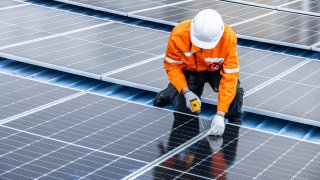MAGA Needs Clean Energy
The Inflation Reduction Act’s clean energy tax incentives should maintain a place in the next administration’s energy policy.
Climate change is an issue of global concern but not a MAGA priority. Clean energy, on the other hand, should be. Conflating the two is a big mistake. Increasing American manufacturing, extraction, and consumption of clean energy—particularly in solar and battery storage—serves vital national interests and should be a primary focus of the Trump 2.0 energy agenda, second only to reversing Biden’s policies hindering U.S. fossil fuel extraction, generation, and consumption.
The Biden administration’s attack on the fossil fuel industry has been bad for America and bad for the environment. Fossil fuels produced and consumed in the United States reduce CO2 emissions merely by shortening the distance oil cargo ships need to travel to reach their destination. Moreover, the U.S. fossil fuel industry is among the world’s most energy-efficient and rapidly improving, with members of the U.S. Oil & Gas Climate Initiative (OGCI) having reduced carbon intensity by over 21 percent since 2017 on a per barrel of oil equivalent basis. Trump 2.0 will rebalance policy priorities by eliminating Biden-era executive orders that stifled American energy production, securing affordable energy for American families and businesses.
After taking this critical first step, Trump 2.0 must also recognize the strategic importance of clean energy to America’s future. Keeping most of the Inflation Reduction Act’s clean energy tax incentives makes sense, not only because of their impact on reducing CO2 emissions but also because of their benefits to the American economy. Here are four compelling reasons for preserving the bulk of Inflation Reduction Act clean energy tax incentives.
First, the United States urgently needs substantially more electric generation capacity to meet the swelling demands of a growing economy. Electricity demand is growing rapidly across multiple sectors of the economy, including data centers, Artificial Intelligence, the Internet of Things, 5G, cloud computing, cryptocurrency mining, a resurgent domestic manufacturing sector, and transportation electrification, among others. The United States will need not only much more generation capacity but also more transmission and distribution capacity.
Failure to meet this challenge successfully will trigger electricity price inflation and drive away companies frustrated with the lack of easy access to competitively priced electricity. It is not unreasonable to expect that the United States will have to significantly increase its generation capacity over the next two decades. Achieving this will require an “all of the above” energy policy. Opening the floodgates to every available generation source will mitigate inflationary pressures and ensure that the United States remains the most attractive place to site this incremental capacity.
Solar and battery storage are uniquely suited to this challenge. Coal, natural gas, nuclear, wind, hydro, and geothermal energy can only be generated and transmitted through centralized power stations and over transmission lines. By contrast, solar and battery storage systems are far more flexible and can be built and dispatched both at grid scale and at the point of consumption for commercial, industrial, and residential users. This flexibility allows for faster permitting and construction timelines while simultaneously reducing pressure on transmission operators. Concerns over the reliance on foreign-sourced solar panels and batteries are being addressed by the new supply and demand side incentives in the IRA to manufacture and consume solar panels and batteries domestically. These must remain and should be further strengthened by Trump 2.0 and the incoming Congress.
Second, the clean energy sector has surged ahead since the first Trump administration and has reached an impressive scale. Global annual investment in the clean energy sector nearly doubled from slightly over $1.2 trillion in 2016 to an estimated $2 trillion in 2024, while global annual investment in the fossil fuel sector declined slightly over the same period. The momentum shift in favor of clean energy is unstoppable and widespread, something that Trump 2.0 must embrace to ensure the United States remains competitive in energy innovation and produces global winners. There is only one American company among the top ten global solar manufacturers and only two among the top ten global energy storage manufacturers. To effectively compete, the United States must provide bipartisan comfort to aspiring companies by reaffirming clean energy dominance as a policy priority.
Third, and related to the second point, if Washington does not continue to support both the supply and demand side of the clean energy sector, China’s current dominance in the sector will be assured for the next decade and beyond. Low-carbon energy sources comprise 40 percent of global electricity consumption, of which over 75 percent comes from renewable energy, and that share is growing steadily. The United States needs to rise to the challenge posed by China, which recognized the opportunity to dominate this sector over fifteen years ago and kept its foot on the accelerator while the United States hit the brakes. With stable bipartisan support, American entrepreneurial genius will produce more winners over time.
Finally, the clean energy boom is delivering massive benefits to red districts across the country. Recent estimates suggest $200–$300 billion in estimated investment and nearly 224,000 jobs flowing into red districts. Trump 2.0 can build on this investment and job growth through a carrot-and-stick approach that encourages domestic investment alongside the prospect of imposing tariffs.
MAGA is about putting America first. That means prioritizing American energy independence, strengthening our economy, and outcompeting global rivals like China. Clean energy has an important role to play in ensuring a prosperous and secure America.
Neil Auerbach is the founder and CEO of Hudson Sustainable Group, an investor in sustainable energy for over two decades, and a former partner of Goldman Sachs. Neil is a senior advisor to the American Conservation Coalition, a grassroots conservative environmental group with over 60,000 members.
Image: Quality Stock Arts / Shutterstock.com.

